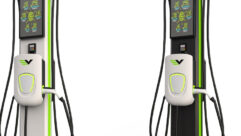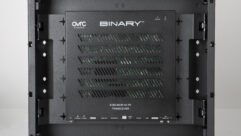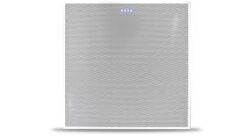
Picture This: Integration
at InfoComm
Aug 1, 2005 12:00 PM,
By Jeff Sauer
Specs can be splashy, but integrated solutions are often more exciting for installers.
As display technology has advanced, we’ve come to expect brighter, smaller, and less expensive projectors and brighter, larger, and less expensive panels. InfoComm 2005 had its share of them. However, as the industry itself matures, real progress will be measured not simply by individual products, but more by how vanguard technologies are integrated into solutions.
Sony’s Ipela line of videoconferencing and security products is an example of the continuing integration of IP with AV. At InfoComm 2005, Sony showed the new PCS-G50, a videoconferencing unit that bridges mixed calls between ISDN and IP networks.
For example, digital signage shows great promise as a new business for contractors in a wide variety of vertical market. But thus far that’s depended mostly on the installer figuring out how to make different products and technologies work together. After seeing a fairly robust Digital Signage Pavilion at the NSCA trade show in March, I was looking forward to seeing major new integration advancements at InfoComm’s own digital signage area.
In terms of digital signage products, much of what was on offer at InfoComm 2005 was from the established players like Scala, WebPavement, and Mercury Online, but there were some new ones as well. For example, ActiveLight introduced a new 40in. LCD panel touchscreen (TActive LCD40) targeting digital signage. Clarity Visual Systems introduced a smart, self-contained, portrait-oriented 60in. plasma called the CoolSign iS60, with wired and wireless networking and a software player to run Clarity’s CoolSign digital signage programming. After literally nothing more than plugging in a power cord, the iS60 can be up and running (provided, of course, that you’re already running CoolSign programming).
Similar to the integration by Clarity, although not actually in the digital signage pavilion, Samsung introduced two new IP-enabled LCD panels — the 40in. and 46in. SyncMaster 400PN and 460PN — for easy and affordable digital signage deployment. Embedded Unix operating systems allow these panels to display content without the need for a local PC at the display end. Samsung’s MagicNet technology can schedule and send AV and signage information over the network, although the panels could also be used with other digital signage software. (Both panels are also available in non-IP configurations at about a 10 percent lower price.)
ViewSonic wasn’t in the pavilion or even on the show floor, but the company introduced a shrewd digital bundle designed as an out-of-the-box solution for a smaller signage installation. The pieces are straightforward: the N1750w 17in. LCD monitor and the black-box MPEG media player WMA100 Wireless Media Adapter. The MPEG hardware is similar to solutions from companies like Electrosonic, Canopus, and Adtec Digital (which, incidentally, introduced a new HD-capable version of its Soloist 3 Digital Media Server), although Viewsonic will bundle the MPEG player with the monitor for about $800. ViewSonic will also sell the WMG120 Media Gateway media server, which distributes media content over wired Ethernet or via built-in wireless 802.11G WiFi to one or more Wireless Media Adapters.
VIDEOCONFERENCING
Sony has been promoting videoconferencing heavily for a couple of years now at InfoComm, and this year the pieces really seemed to be coming together. Ipela is Sony’s new brand name for IP-enabled videoconferencing equipment, which now can feature image quality that’s comparable to standard-definition television. The new Ipela PCS-TL30 is a desktop LCD monitor equipped with a built-in camera that can double as a standard PC monitor and videoconferencing unit. The Ipela PCS-G50 is a standalone installation module. Both support both H.263 and H.264 video compression.
Sony also announced an intriguing partnership with GlowPoint, creators of IVE, or “Instant Video Everywhere.” IVE is a mobile service that works much like a cellular phone service plan. Subscribers get a phone number and can make calls to any other standard phone number. The difference is that they do it through a piece of software that looks like a Media Player with a dial pad. If the person called subscribes to the service as well, or has some other standard videoconferencing capability, the audio call becomes a video call. It’s that easy — arguably the easiest way into videoconferencing since AT&T started playing around with videophones in the 1970s.
Advanced Media Designs is not a videoconferencing company per se, but the company does make products that integrate into videoconferencing infrastructures. Think about personal video recorders (TiVo, if you will) for a videoconferencing system. The company’s MediaPointe series of Digital Media Recorders are appliances with one-button simplicity that can literally record a videoconference call to a hard drive. Depending on the flavor of MediaPointe, you can also record MPEG video of the person on the call (or both parties on the call with the high-end DMR300) separately from any presentation slides or material, which are saved as still-image JPEGs.
PROJECTING THE FUTURE
Finally, DLP-based XGA projector models from several companies are coming close to the magical $1,000 price point, and Epson (not on the show floor) now has two SVGA PowerLite models for less than $800. And amazingly, many microportables (under 6lbs.) now are brighter than 2000 lumens. However, the most exciting two projectors at InfoComm 2005 were the biggest and the smallest.
Introduced last year as a technology demonstration, the Sony SRX-R110 10,000-lumen and SRX-R105 5000-lumen 4K digital cinema projectors are now shipping. By making film-resolution projection a reality, these projectors are bringing the future of digital cinema a lot closer. They also give control rooms the option of two side-by-side full HD-resolution sources or four full-resolution XGA sources on a single screen.
The projector that gives the industry the most to think about, though, is Mitsubishi’s Pocket Projector, the sub-1lb., palm-of-the-hand-sized projector that was first shown as a technology demonstration at CES in January. The Pocket Projector is only SVGA resolution and only 20 or so lumens, but it’s also only $699 for the base version. It’s really quite remarkable, but no one at Mitsubishi really knows what anyone is going to do with this projector. Yet the theories abound: integrating it into automobiles; using it for gaming, retail signage, or mood enhancement; making it a big-screen display for a palm-sized computer/organizer; or just keeping it handy for presentations in a pinch. That last one is the most obvious, given the history of the projection industry. However, the most intriguing thing for the industry is that it’s also probably the least likely.










